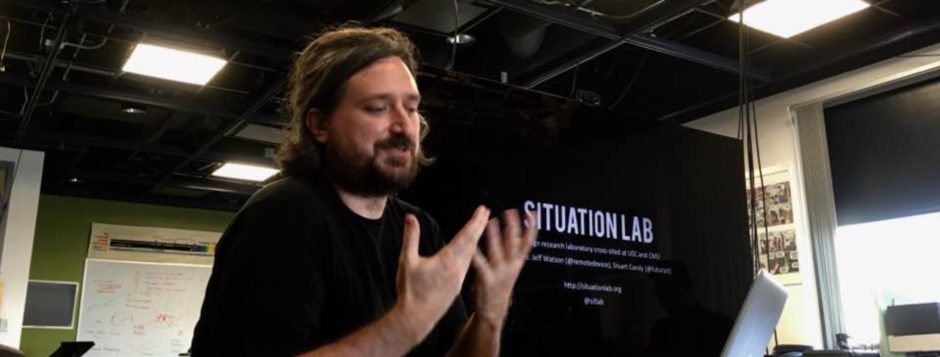[intro]Mark Shepard is an artist, architect and researcher whose post-disciplinary practice addresses new social spaces and signifying structures of contemporary network cultures. His current research investigates the implications of mobile and pervasive media, communication and information technologies for architecture and urbanism. His current project, the Sentient City Survival Kit, [which includes the iPhone app, Serendipitor] has been exhibited at the Center for Architecture, New York; the International Architecture Biennial Rotterdam, the Netherlands, LABoral Center for Art and Industrial Creation, Gijon, Spain; ISEA 2010 RUHR, Dortmund Germany, and the Albright-Knox Art Gallery, Buffalo, New York.[/intro]
What was your trajectory into this kind of art practice?
I come from a background in Architecture and Media Art, and have been experimenting with alternate trajectories for what has come to be called urban computing for about ten years now. I have always been fascinated with cities and technology, and my practice has emerged out of a curiosity regarding how forms of mobile and embedded, networked and distributed computing can shape our experience of the city and the choices we make there.
Most location- and context-sensitive apps are about making things faster and more efficient. Serendipitor slows things down and disrupts the flow. Why do you think this is an important thing to do?
Computer science and engineering are practices that hold optimization and efficiency as important design challenges. And that’s all well and good when we’re talking about relatively instrumental applications of these technologies in urban environments. But artists frame questions in ways scientists and engineers do not, and when considering the implications of these technologies for urban life, one has to wonder what other criteria could be relevant. Who really wants a faster, seamless, more optimal and efficient life?
Projects like this are inherently multiple — even paradoxical. As you write on your website (quoting Deleuze), “AND is neither one thing nor the other, it’s always in-between, between two things.” Why does this kind of instability inspire you?
Well, as Deleuze says a little further on in that quote “it’s along this line of flight that things come to pass, becomings evolve, revolutions take shape.” Much of my work looks for ways out of static dichotomies that serve to maintain the status quo. Destabilizing tactics often reveal the more subtle and nuanced forces at play in a given situation, and help open up lines of thinking that can help us move beyond established belief systems.
How have people been using the app? What kind of feedback have you received — and what kind of data have you gathered?
The feedback has been surprisingly positive. People seem to really enjoy the app, and have been using it around the world. Many have suggestions of their own, ideas for new instructions, ways to share their routes, etc. Much of this is anecdotal in nature, however, and I do think that the plural of anecdote is not data.
What were you looking for when you set out to design Serendipitor? And what did you end up finding?
Serendipitor is one component of a larger project called the Sentient City Survival Kit (http://survival.sentientcity.net), a project that explores the implications for privacy, autonomy, trust and serendipity in this highly optimized, efficient and over-coded “smart” city heralded by ubiquitous computing evangelists for some time now. With Serendipitor, what started as an ironic proposition – that in the near-future, finding our way from point A to point B will not be a problem, but maintaining consciousness along the way might be more difficult, and that we would need to download an application for “serendipity” from the App Store – turned out to be quite popular when implemented as an app. I didn’t expect to find that the irony could be so easily lost in the process!
What’s next — for you, and for smartphone-enabled humanity?
Smartphone-enabled non-humanity, of course. 😉
